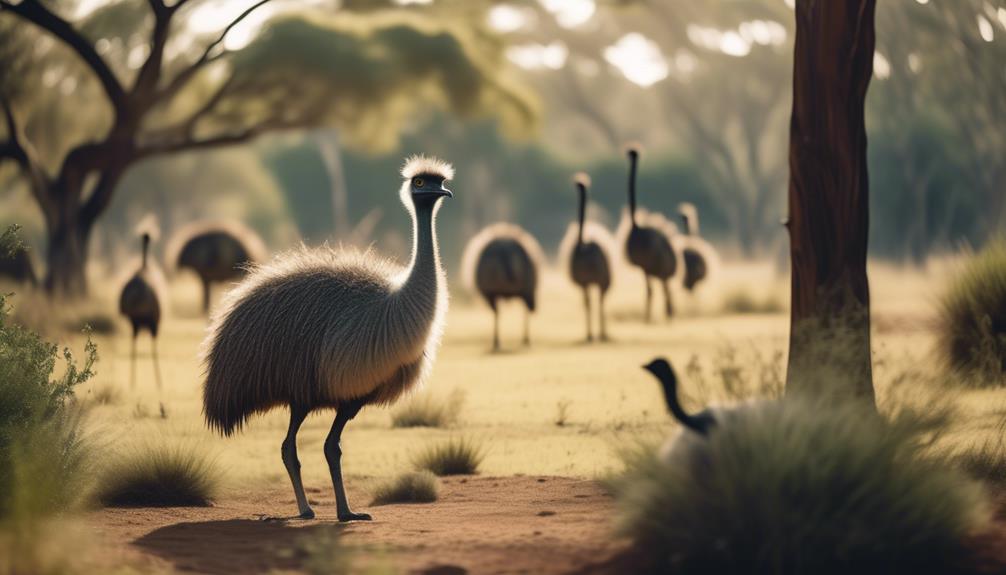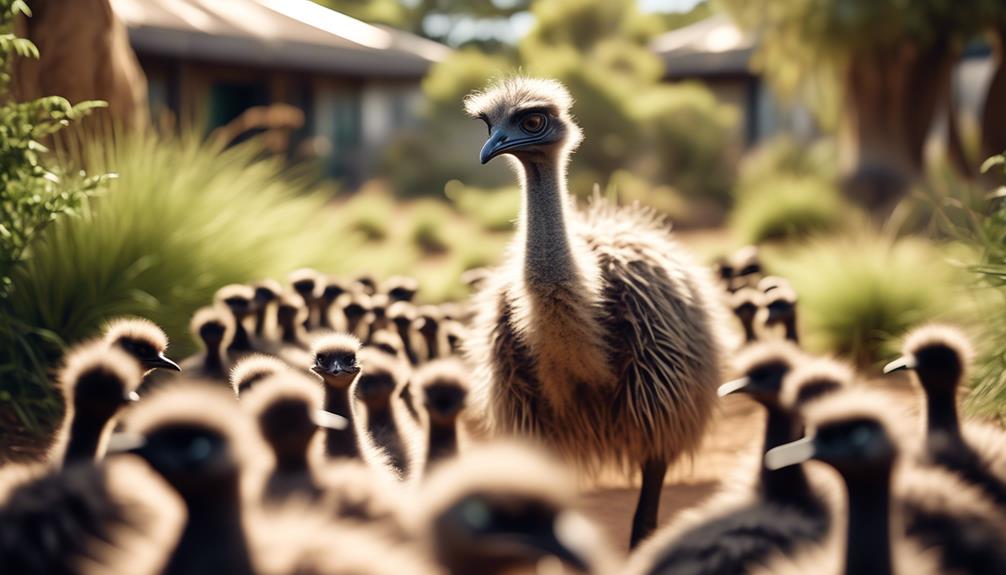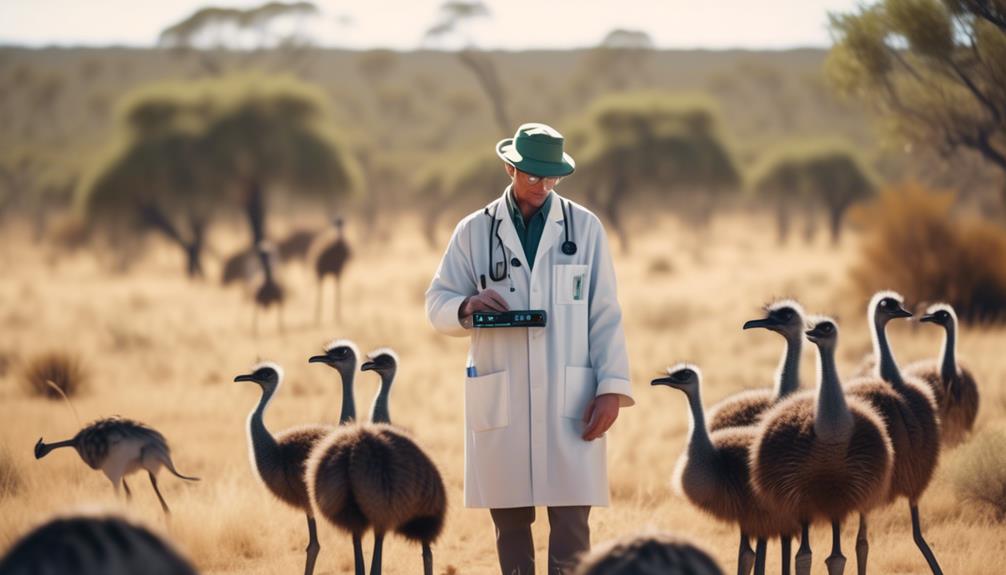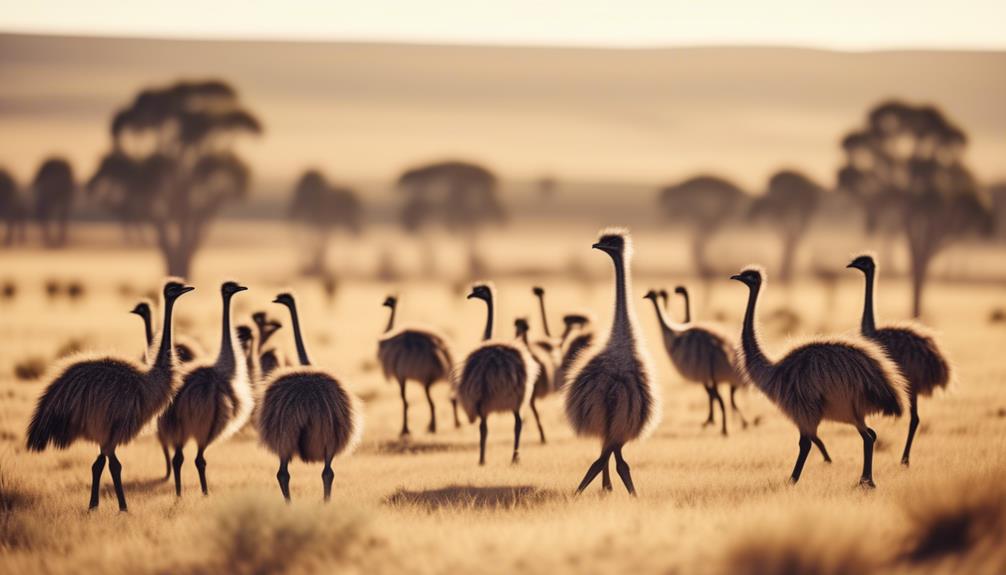
As you embark on a journey through the fascinating world of emu conservation, you will discover the pivotal role that sanctuaries and reserves play in safeguarding these iconic creatures.
Beyond their symbolic representation of resilience and survival, emus face numerous threats that put their very existence at risk.
However, the establishment of sanctuaries and reserves has provided a glimmer of hope, offering safe havens and breeding grounds where these majestic birds can thrive.
But what exactly do these sanctuaries entail, and how do they contribute to the conservation efforts?
Join us as we delve into the intricacies of emu conservation and explore the vital role of sanctuaries and reserves in protecting these magnificent creatures.
Key Takeaways
- Emu conservation is important for ecosystem stability and the preservation of biodiversity.
- Sanctuaries and reserves play a crucial role in protecting emus and providing safe habitats for their survival.
- Breeding programs in sanctuaries enhance emu populations and maintain genetic diversity.
- Research efforts are essential in understanding emu biology, threats, and effective conservation strategies.
Importance of Emu Conservation
Emu conservation is of utmost importance due to the significant role that these flightless birds play in maintaining the ecological balance of their native habitats. Emus are key contributors to ecosystem stability as they help control vegetation growth, disperse seeds, and influence nutrient cycling. Their foraging activities promote the growth of diverse plant species and prevent the dominance of certain plants, thus enhancing habitat biodiversity.
Conservation efforts are crucial to ensure the long-term survival of emus and their habitats. Protecting their native habitats through the establishment of sanctuaries and reserves is essential. These protected areas provide emus with suitable nesting sites, ample food sources, and safe breeding grounds. By safeguarding these habitats, we aren't only preserving the emus themselves, but also the myriad of other species that depend on these ecosystems for survival.
Effective conservation also involves mitigating threats faced by emus, such as habitat loss, invasive species, and human activities. Conservation programs focus on habitat restoration, predator control, and public education to raise awareness about the importance of emu conservation. By involving local communities and stakeholders in conservation efforts, we can foster a sense of responsibility and stewardship towards these remarkable birds.
Threats to Emu Survival
To ensure the long-term survival of emus and their habitats, it's essential to understand the threats that pose a risk to their existence. Emus face numerous challenges, primarily due to human impact and habitat loss.
- Human Impact: Emus are vulnerable to various forms of human impact. One significant threat is hunting, as emus are often targeted for their meat, feathers, and eggs. Additionally, collisions with vehicles on roads and highways can result in fatalities or severe injuries. Disturbance caused by human activities, such as urban development and tourism, can disrupt emus' natural behaviors and stress them, leading to negative consequences for their survival.
- Habitat Loss: Emus rely on a specific habitat for their survival, which includes open grasslands, woodlands, and shrublands. However, habitat loss due to land clearing for agriculture, urbanization, and infrastructure development poses a significant threat. When their habitat is fragmented or destroyed, emus face challenges in finding suitable resources for food, shelter, and breeding. This loss of habitat also increases their vulnerability to predation and decreases their overall population size.
Understanding and addressing these threats is crucial for the long-term survival of emus. Conservation efforts should focus on minimizing human impact, protecting and restoring their habitats, and promoting sustainable practices that coexist with emu populations.
It's through these measures that we can ensure the continued existence of these magnificent birds and their ecosystems.
Role of Sanctuaries in Protecting Emus

Sanctuaries play a crucial role in safeguarding the emu population and their habitats. By providing protected areas where emus can thrive, sanctuaries contribute to the overall conservation efforts aimed at preserving this iconic Australian species. Emu sanctuaries are carefully designed to meet the specific needs of these flightless birds, offering ample space, suitable vegetation, and protection from potential threats.
One of the key aspects of the role of sanctuaries in emu protection is the provision of suitable foraging grounds. Emus are herbivores, and their diet primarily consists of grasses, fruits, seeds, and insects. Sanctuaries ensure that emus have access to a diverse range of vegetation, allowing them to meet their nutritional requirements throughout the year. Additionally, these protected areas often implement sustainable land management practices, which help maintain the quality and abundance of food sources for emus.
Table: Emu Sanctuaries and their Contributions to Emu Protection
| Sanctuary Name | Location | Key Contributions |
|---|---|---|
| Sanctuary A | Region X | Protecting emu habitats, providing suitable foraging grounds |
| Sanctuary B | Region Y | Conducting research on emu behavior and habitat requirements |
| Sanctuary C | Region Z | Rehabilitating injured or orphaned emus, promoting breeding programs |
Emu sanctuaries also play a vital role in research and conservation efforts. They provide opportunities for scientists and experts to study emu behavior, habitat requirements, and population dynamics. This knowledge helps inform effective management strategies and conservation plans for emus in both sanctuaries and the wild.
Furthermore, sanctuaries often engage in rehabilitation programs for injured or orphaned emus. These initiatives aim to provide necessary care and support to emus in need, with the ultimate goal of releasing them back into their natural habitats. Additionally, some sanctuaries actively promote breeding programs to enhance the emu population and genetic diversity.
Providing Safe Habitats for Emus
By ensuring the availability of suitable habitats, sanctuaries contribute significantly to the protection and preservation of emu populations. Providing safe habitats is a crucial aspect of conservation efforts for these magnificent birds. Here are three ways in which sanctuaries play a vital role in creating safe habitats for emus:
- Land Management: Sanctuaries carefully manage their land to create suitable habitats for emus. This includes maintaining a diverse range of vegetation types, such as grasslands and shrublands, which provide essential food sources and cover for emus. By carefully controlling factors like grazing and fire regimes, sanctuaries ensure that the habitat remains suitable for emus to thrive.
- Protection from Predators: Emus face numerous threats from predators, including foxes and feral cats. Sanctuaries implement predator control programs to reduce the impact of these predators on emu populations. This involves strategies such as trapping, baiting, and fencing to create predator-free zones within the sanctuary, providing a safe space for emus to breed and raise their young.
- Minimizing Human Disturbance: Sanctuaries are designed to minimize human disturbance, creating a peaceful environment for emus to flourish. Measures such as restricted access, designated walking trails, and education programs help visitors understand the need to maintain a safe distance from emus and avoid disturbing their habitats. This ensures that emus can go about their natural behaviors without unnecessary stress or disruption.
Through these efforts, sanctuaries play a vital role in providing safe and secure habitats for emus, contributing to the conservation of these remarkable birds.
Promoting Breeding Programs

One important aspect of emu conservation involves actively promoting breeding programs. Breeding partnerships are crucial in maintaining genetic diversity within emu populations. By carefully selecting suitable mates, conservationists can ensure that the offspring have a diverse genetic makeup, which increases their chances of survival and adaptability to changing environments.
Breeding programs often involve partnerships between different sanctuaries and reserves. This allows for the exchange of genetic material between emus from different locations, preventing inbreeding and promoting healthy populations. By collaborating with other institutions, conservationists can increase the gene pool and improve the overall genetic health of emus.
To facilitate successful breeding programs, conservationists closely monitor the reproductive behavior of emus. They observe mating rituals, nesting habits, and incubation processes. By understanding the natural reproductive behaviors of emus, conservationists can provide the necessary conditions and support for successful breeding.
Additionally, genetic testing is conducted to assess the genetic diversity within emu populations. This information helps conservationists make informed decisions about breeding pairs, ensuring that genetic diversity is maintained and enhanced. By promoting breeding programs and maintaining genetic diversity, conservationists can contribute to the long-term survival and adaptability of emus in their natural habitats.
Rehabilitation and Release of Emus
To ensure the overall well-being and successful integration of emus back into their natural habitats, the rehabilitation and release of these birds requires careful planning and implementation. Emus that have been rescued or orphaned need to undergo a series of rehabilitation practices to prepare them for release. These practices involve providing appropriate nutrition, medical care, and behavioral training to help emus regain their natural instincts and physical abilities.
Rehabilitation practices for emus typically include:
- Diet and nutrition management: Emus are fed a balanced diet that consists of a variety of fruits, vegetables, grains, and protein sources to ensure they receive all the necessary nutrients for their growth and development. They may also be supplemented with vitamins and minerals to address any deficiencies.
- Physical therapy and exercise: Emus that have been injured or have spent significant time in captivity may require physical therapy to regain their strength and coordination. This can involve exercises such as walking, running, and stretching to help emus build muscle and improve their mobility.
- Environmental enrichment: Emus in rehabilitation need to be exposed to natural elements and stimuli to help them adapt to their future release environment. This can include providing them with access to open spaces, natural vegetation, and opportunities for social interaction with other emus.
Release strategies for emus focus on ensuring a smooth and successful transition back into the wild. Some key considerations include:
- Soft-release techniques: Emus are gradually acclimated to their natural habitat by first being released into a semi-wild enclosure. This allows them to adjust to their surroundings while still having access to supplemental food and shelter. Over time, they're given more freedom until they're fully released into the wild.
- Monitoring and tracking: Released emus are closely monitored to evaluate their behavior, movement patterns, and overall well-being. This information helps conservationists assess the success of the release and identify any potential issues that may need to be addressed.
- Post-release support: Emus that have been released may require ongoing support, such as supplementary feeding or medical intervention, especially during their initial phase of independence. This support ensures that they've a higher chance of survival and successful integration into the wild population.
Research Efforts in Emu Conservation

Research efforts in emu conservation have played a crucial role in understanding the biology, behavior, and threats faced by these unique flightless birds. Scientists have conducted extensive studies to gather data on emu populations, their habitat requirements, and the impact of human activities on their survival. By monitoring emu populations, researchers can assess the health and stability of the species, identifying trends and potential threats.
One area of research focuses on habitat restoration, as it's vital for the long-term conservation of emus. Scientists study the specific habitat preferences of emus, such as open grasslands and woodlands, to determine the most effective methods for restoring and maintaining suitable environments. They analyze factors like vegetation structure, water availability, and the presence of predators to create guidelines for habitat management and restoration projects.
Furthermore, research efforts have shed light on the impact of habitat fragmentation on emu populations. Fragmentation disrupts their movement patterns, breeding behaviors, and access to food and water sources. By studying these effects, scientists can propose strategies to mitigate the negative impact of habitat fragmentation, such as creating wildlife corridors or implementing land-use planning that considers the needs of emus and other wildlife.
Education and Awareness Initiatives
Education and awareness initiatives play a crucial role in promoting the conservation of emus and fostering public understanding of their ecological importance. By raising awareness through targeted campaigns and implementing educational programs, individuals can learn about the challenges facing emus and contribute to their protection.
Here are three key ways in which these initiatives are making a difference:
- Awareness campaigns: Through various media platforms, awareness campaigns aim to inform the public about the threats faced by emus and the need for their conservation. These campaigns utilize compelling visuals, engaging storytelling, and clear messaging to capture the audience's attention and evoke empathy towards these unique birds.
- Educational programs: Educational programs provide individuals with the knowledge and tools necessary to understand the ecological importance of emus and the actions they can take to support their conservation. These programs can be tailored to different age groups and include interactive activities, presentations, and field trips to engage participants and deepen their understanding of emus and their habitats.
- Community engagement: Education and awareness initiatives also involve actively engaging local communities in the conservation efforts. By organizing workshops, community events, and volunteer programs, these initiatives create opportunities for individuals to directly contribute to emu conservation. This engagement fosters a sense of ownership and responsibility among the community members, leading to long-term commitment towards protecting emus and their habitats.
Through these awareness campaigns and educational programs, efforts are being made to ensure that the public understands the importance of emus in maintaining ecosystem balance and biodiversity. By fostering a connection between people and these magnificent birds, these initiatives are paving the way for a brighter future for emus and their habitats.
Collaboration With Local Communities

By actively involving local communities, emu conservation initiatives can harness the power of collective action to protect these unique birds and their habitats. Collaboration with local communities is crucial in ensuring the success and sustainability of emu conservation efforts.
To effectively engage communities, conservation organizations employ various collaboration strategies and community engagement approaches.
One effective strategy is to establish partnerships with local community groups, such as indigenous communities or landowners, who have a vested interest in the conservation of emus. These partnerships foster a sense of ownership and stewardship among community members, enhancing their commitment to protecting emus and their habitats.
Additionally, collaboration strategies may include organizing community workshops and educational programs. These initiatives aim to raise awareness about emu conservation and provide community members with the knowledge and skills necessary for active participation. By involving community members in hands-on activities such as habitat restoration or monitoring, individuals feel a sense of connection and empowerment, further strengthening their commitment to conservation efforts.
Community engagement is also vital in gathering local knowledge and traditional ecological knowledge. Local communities often possess valuable insights about emu behavior, habitat preferences, and threats faced by these birds. By incorporating this knowledge into conservation plans, initiatives can be tailored to the specific needs and circumstances of the local community and the emus themselves.
Monitoring and Conservation Success Stories
Monitoring efforts and conservation success stories provide valuable insights into the effectiveness of emu conservation initiatives. By implementing various monitoring techniques, researchers and conservationists can gather data on emu populations and their dynamics, allowing for better-informed conservation strategies.
Here are three examples of successful monitoring and conservation efforts:
- Radio telemetry: Researchers attach radio transmitters to a sample of emus to track their movements and behaviors. This technique provides valuable information on their habitat preferences, migration patterns, and breeding behaviors, helping conservationists identify critical areas for protection.
- Population surveys: Regular surveys using systematic sampling methods, such as line transects or aerial surveys, allow for accurate estimates of emu populations. These surveys help monitor population trends, identify potential threats, and evaluate the effectiveness of conservation interventions.
- Citizen science: Engaging the public in monitoring efforts through citizen science initiatives has proven to be a successful strategy. By encouraging individuals to report emu sightings or contribute to data collection, large-scale monitoring becomes more feasible, providing valuable insights into emu distribution and abundance.
Through the use of these monitoring techniques, conservationists have been able to gain a better understanding of emu population dynamics, identify key areas for protection, and evaluate the success of conservation interventions. These success stories highlight the importance of ongoing monitoring efforts in ensuring the long-term survival of emus.
Future Challenges and Opportunities in Emu Conservation

To address the future challenges and opportunities in emu conservation, it's crucial to explore emerging research areas and innovative approaches that can further enhance our understanding and conservation efforts. Emus face a number of challenges that threaten their population, including habitat loss, predation, disease, and climate change. These challenges necessitate the development of targeted conservation strategies to ensure the long-term survival of this iconic species.
One emerging research area is the study of emu genetics. Genetic research can provide valuable insights into the population structure, genetic diversity, and evolutionary history of emus. Understanding the genetic makeup of emu populations can inform conservation efforts by identifying genetically distinct populations that require special attention and management.
Another research area with great potential is the use of advanced tracking technologies to monitor emu movements and behavior. By tracking emus, researchers can gain a better understanding of their habitat preferences, migratory patterns, and response to environmental changes. This information can guide the establishment of protected areas and the implementation of targeted conservation actions.
Furthermore, there are opportunities to collaborate with indigenous communities and incorporate their traditional ecological knowledge into emu conservation efforts. Indigenous communities have a deep understanding of the land and its biodiversity, and their involvement can greatly enhance conservation practices.
Addressing these challenges and seizing these opportunities will require collaboration between scientists, conservation organizations, policymakers, and local communities. By working together, we can ensure a brighter future for emus and their habitats.
Frequently Asked Questions
Are Emus Endangered?
Emus are not endangered, but their population has been declining due to habitat loss and hunting. Conservation efforts are crucial to ensure their survival. Sanctuaries and reserves play a vital role in protecting and preserving these majestic birds.
How Do Sanctuaries and Reserves Contribute to Emu Conservation?
Sanctuaries and reserves play a crucial role in emu conservation. Through captive breeding programs, they help increase the emu population. Additionally, by preserving their natural habitats, these protected areas ensure their survival and promote biodiversity.
What Are the Main Threats to Emu Survival?
The main threats to emu survival include habitat loss, which has a significant impact on their conservation. Emu conservation faces challenges due to the loss of suitable habitats, affecting their population and overall survival.
How Do Breeding Programs Help in the Conservation of Emus?
Breeding programs play a crucial role in emu conservation. By managing captive populations, these programs ensure genetic diversity and help prevent the decline of emus in the wild.
What Are Some Examples of Successful Emu Conservation Projects?
Successful emu conservation projects have made significant contributions to the preservation of these unique birds. Emu conservation efforts in Australia, through initiatives like breeding programs and habitat restoration, have helped ensure the long-term survival of emus.
Conclusion
In conclusion, the role of sanctuaries and reserves in emu conservation is vital. By providing safe habitats, promoting breeding programs, and implementing education initiatives, these sanctuaries play a crucial role in ensuring the survival of emus.
Collaborating with local communities and monitoring conservation efforts are also key aspects. As we continue to face future challenges and opportunities in emu conservation, it's important to remember that 'every cloud has a silver lining' – meaning that even in difficult times, there's a potential for positive outcomes.





